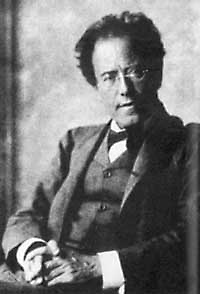Mahler's Real Nature by Jacques Desjardins
/ June 1, 2001
Version française...
On May 18, 2001, the musical world celebrated the 90th anniversary of Gustav Mahler's death. Since the resurrection (literally) of the composer's work at the beginning of the sixties by Leonard Bernstein, public interest has never waned. Mahler's music attracts and transports the crowds to planes more metaphysical than physical. At this new turn of a century, we feel it is important to highlight the composer's exceptional contribution in the last one. Mahler the conductor, Mahler the composer, Mahler the visionary, are all tributaries of an earthly “holy trinity” intimately linked to his admiration for nature.
 How better to show Mahler's profound love of Nature (capital “N”) than through his first symphony? It is no coincidence that Mahler himself wrote as an epigraph to the first movement “Wie ein Naturlaut” (Like a cry of nature). From the first bars, one hears a note, floating in time and space, spanning six octaves, a rustle, directly from Germany's Black Forest on a beautiful summer night. Then crickets pierce the silence of the night with their shrill chirps. Following which, birds greet the dawn with soaring song as the sun rises on the horizon. A solitary wanderer then appears, to pay homage to this whole scene with the brisk stride of one who deems himself to be the “master of the woods.”
How better to show Mahler's profound love of Nature (capital “N”) than through his first symphony? It is no coincidence that Mahler himself wrote as an epigraph to the first movement “Wie ein Naturlaut” (Like a cry of nature). From the first bars, one hears a note, floating in time and space, spanning six octaves, a rustle, directly from Germany's Black Forest on a beautiful summer night. Then crickets pierce the silence of the night with their shrill chirps. Following which, birds greet the dawn with soaring song as the sun rises on the horizon. A solitary wanderer then appears, to pay homage to this whole scene with the brisk stride of one who deems himself to be the “master of the woods.”
I associate the forest rustle to the pedal A at the beginning of the symphony, the sunrise theme to the fourths played by the woodwinds in the subsequent long values and the bird songs to the short value fourths pattern. The “human” elements are represented by the trumpet calls starting on the ninth bar as an initial “disturbance” in the surrounding calm and by the theme of the wanderer taken from the song “Ging heut' Morgen über's Feld” from the Lieder eines fahrenden Gesellen cycle.
This illustration should not be taken literally. Mahler himself had originally accompanied his symphony with a text that he intended as a program. Disappointed by the extravagant interpretations which the public and specialists had made of it, he later decided to replace it with the simple “cry of nature” mentioned above. Even if the characters I selected must not be taken too seriously, the composer still meant to express the waking of nature in the first few bars of his symphony. In this sense, my scenario comes close to the creator's initial intention.
The pastoral or folk themes evoked elsewhere in the symphony confirm this interpretation. One need only think of the first theme of the second movement, a dancing three-beat melody very close to the Ländler, or to the gypsy feel of the second theme in the third movement with its cymbals and off-beats. As it happens, Mahler gives an indication in the score for the musicians to play “mit parodie” (with parody)! This music's surprising humour is in stark contrast with the movement's grave opening theme of the “Frère Jacques” melody in minor mode with voluntarily sombre tones (muted timpani and double bass solos, bassoon, tuba and clarinet).
These contrasts are typical of the impetuous and changing character of the composer, as described by his friend, musicologist Guido Adler. The latter talks of Mahler as being at times so absorbed in his art that he would spend long periods as a hermit without seeing anyone. At other times, however, he was perfectly capable of playing tricks on people close to him and enjoying himself with friends. We are far from the image of the constantly tormented creator presented by Ken Russell in his film. True, Mahler's failing health near the end of his life tormented him, but a realistic portrait of the great figure must include, along with the sombre passages the more luminous ones of his music. And right from the start the first symphony shows how true the creator was to his identity. •
[Translated by Alexandre Lebedeff]
Version française... |
|


